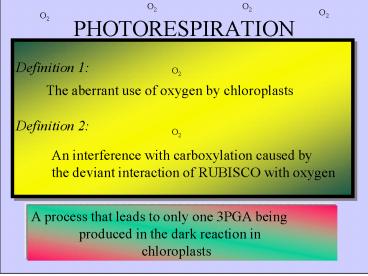PHOTORESPIRATION - PowerPoint PPT Presentation
1 / 14
Title:
PHOTORESPIRATION
Description:
O2 O2 PHOTORESPIRATION Definition 1: O2 The aberrant use of oxygen by chloroplasts Definition 2: O2 An interference with carboxylation caused by the deviant ... – PowerPoint PPT presentation
Number of Views:1966
Avg rating:3.0/5.0
Title: PHOTORESPIRATION
1
PHOTORESPIRATION
O2
O2
O2
O2
Definition 1
O2
The aberrant use of oxygen by chloroplasts
Definition 2
O2
An interference with carboxylation caused by
the deviant interaction of RUBISCO with oxygen
A process that leads to only one 3PGA being
produced in the dark reaction in chloroplasts
2
O2
RuBP
Phospho- glycolate
3PGA
Peroxisomes
Glycolate
Calvin Cycle
Photoefficiency is cut in half
3
Peroxisome between 2 chloroplasts
Chloroplast
4
From Chloroplasts
O2
Mitochondria
Glycolate
2
Glycine
CO2
ATP
3PGA
Serine
Peroxisomes
5
Why Photorespiration?
1. O2 (21 of air) is more prevalent than CO2
(0.03)
2. RUBISCO reacts with O2 (Km 200 ?M) as well
as CO2 (Km20 ?M)
RUBISCO IS BOTH AN OXYGENASE and a CARBOXYLASE
3. Phosphoglycolate can be salvaged. Glycine
? Serine (mitochondria)releases CO2 Glycolate
? Glyoxylate (peroxisomes) consumes O2
O2 in CO2 out is respiration
6
Strategy for Preventing Photorespiration
PLAN
Avoid RUBISCO
Fix CO2 in an environment shielded from O2
Use an enzyme that does not react with O2
7
Strategy (cont.)
SOLUTION
CO2 fixation occurs in Mesophyll cells
CO2 fixing enzyme is not RUBISCO
CO2 fixing enzyme is PEP carboxylase
PEP carboxylase will not react with O2
RUBISCO never changed
Instead plant anatomy changed
8
Anatomy of C3 vs C4 Plants
Calvin Cycle Cells
9
Mesophyll cell
Bundle-sheath cell
Oxaloacetate
Malate
Malate
Calvin cycle
PPi Pi
CO2
CO2
ATP
AMP
CO2
Phosphoenol- pyruvate
pyruvate
pyruvate
ATP energy is required to concentrate CO2
in bundle-sheath cells
10
Hatch-Slack C4 Pathway for concentrating CO2
Mesophyll cell
2Pi
Malate dehydrogenase
Pyruvate phosphate dikinase
CO2
PEP
OAA C4
Malic enzyme
CO2
RUBISCO
Bundle-sheath cell
11
Key Points
1. Mesophyll cells have no RUBISCO Bundle
Sheath do
2. Mesophyll cells condense CO2 with PEP-C4 cycle
3. OAA and malate are the C4 components
4. In bundle sheath cells malate is oxidatively
decarboxylated to pyruvate to release
the CO2
5. CO2 released enters the Calvin Cycle-C3 cycle
6. In mesophyll cells, pyruvate is converted to
PEP by the enzyme pyruvate-phosphate dikinase
7. Pyruvate-phosphate dikinase uses the
equivalent of 2 ATPs to synthesize PEP
12
C3 vs C4 PlantsA Lesson in Photoefficiency
C3
C4
- CO2 directly
- RuBP recipient
- RUBISCO open
- O2 can interfere
- Photorespiration likely
- CO2 indirectly
- PEP recipient
- RUBISCO shielded
- O2 cannot interfere
- No photorespriation
13
C3 and C4 Plants
C3
C4
- soybean
- wheat
- rice
- sugar beet
- alfalfa
- spinach
- tobacco
- sunflower
- corn
- sorghum
- sugar cane
- millet
- crab grass
- Bermuda grass
- pigweed
14
What did you Learn?
- Photorespiration is to be avoided
- RUBISCO is an oxidase/carboxylase
- Oxygen cuts photoefficiency in half
- C3 and C4 plants differ in anatomy
- Mesophyll cells fix CO2 to PEP
- Bundle sheath cells have Calvin cycle
- C4 plants grow more ferociously

